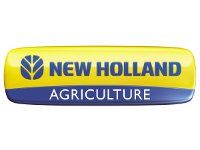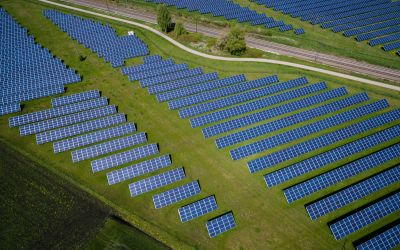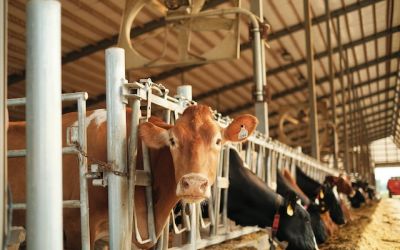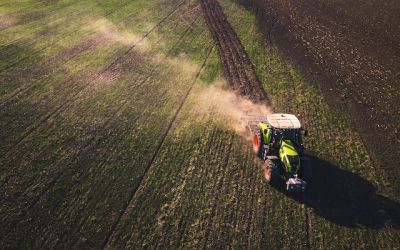New Holland Agriculture’s clean energy leader strategy
The growing importance of environmental issues, their close connection to the agricultural business and the uncertainty linked to the price and availability of fossil fuels were the basis for developing the New Holland Clean Energy Leader strategy which has been in place since 2006.

The growing importance of environmental issues, their close connection to the agricultural business and the uncertainty linked to the price and availability of fossil fuels were the basis for developing the New Holland Clean Energy Leader strategy which has been in place since 2006.
The Brand had undertaken and continues to invest extensively in developing cutting-edge solutions and researching new technologies which reduce the impact of agricultural machines on the environment, while concurrently improving farming efficiency. New Holland’s Clean Energy Leader strategy is based on four fundamental elements for environmental respect including biodiesel, biomass, Tier 4 emissions regulations, the NH2™ hydrogen tractor and the Energy Independent Farm concept.
Biodiesel
New Holland is internationally recognized as the pioneer in the use of renewable fuels, and was the first manufacturer to offer 100% B100 biodiesel compatibility for its products back in 2006. Over the last years, further research has been conducted into biodiesel’s agricultural applications, and as of 2010, 90% of New Holland tractors and harvesting equipment were able to operate on 100% biodiesel. The Brand has further confirmed its commitment to this environmentally friendly fuel, by investing in extensive research into biodiesel’s place within its Tier 4A engine strategy. Today New Holland products equipped with Tier 4 ECOBlue™ SCR fuel efficient engines can run on commercially available fuels containing Biodiesel blends of up to and including 5% Biodiesel (B5) (North America - ASTM D6751-9a) and 7% Biodiesel (B7) (Europe - EN 590:2009). New Holland approves the use of 20% Biodiesel (B20) blends with all Tier 4 ECOBlue™ SCR engines as long as the Biodiesel blend fully complies with the latest fuel specification EN14214:2009 and operation is in accordance with operator's manual guidelines.
Biomass
New Holland believes biomass is a proven option for energy generation. Biomass used in today's power plants includes wood residues, agricultural/farm residues, food processing residues and methane gas from landfills. In the future, farms cultivating crops could significantly expand the supply of biomass feedstock. New Holland offers farmers a complete range of specialist equipment like its range of balers, the FR9000 self propelled forage harvester and the coppice header 130FB which can be used to harvest both vegetal and woody biomass. New Holland also offers simple solutions to grow energy in markets where agricultural mechanization and rural electrification are key to development. A New Holland fleet of 105 tractors, 45 square balers, 15 rakes and two mowers is currently working in a rural biomass power generation project in the State of Punjab, India, which will deliver 45 megawatt of renewable energy to the State power grid.
Tier 4A emissions regulations
The United States Environmental Protection Agency (EPA) and the European Union have set increasingly stringent emissions targets since 1996 to improve air quality, starting from Tier 1 through to Tier 3. The Tier 4 regulations will be introduced in more phases: the first , which has begun on January 1st, 2011, with Tier 4A standards for medium- and heavy-duty engines above 174 hp (130 kW), and the final one, Tier 4B, starting from 2014. When Tier 4B regulations will come into effect Particulate Matter (PM) and Nitrogen Oxides (NOx) will be reduced by 90% compared to Tier 3 levels. As emissions standards have tightened over the years, New Holland has always been committed to providing equipment with emissions and noise levels well below regulatory levels. We have achieved these results through the introduction of advanced solutions such as the Common Rail engine technology, which was invented by Fiat , and has now been adopted as an industry standard. In developing our solutions to the Tier 4 requirements, we were able to draw on the extensive experience of FPT Industrial, our engine development partner within the Fiat Industrial Group. FPT Industrial is the leader in environmentally friendly engines and has pioneered low emission systems by offering the Selective Catalytic Reduction (SCR) technology in on- and off-highway applications. To date, over 150,000 engines that effectively use SCR technology have been produced for the haulage industry. This technology is being continually developed and refined, and the result is low operating costs and high productivity with low emissions at a competitive price.
Sponsored Content
New Holland has the widest range of Tier 4A compliant products currently on the market, with 20 tractors and 9 combines, all benefiting from the advantages ECOBlue™ SCR technology offers: more power, more torque, more fuel economy and more productivity. New Holland will exclusively use ECOBlue™SCR technology to meet the even more stringent final 2014 Tier 4B regulations for medium- and heavy-duty engines. This means unaltered machine operation and investment ploughed into the next generation of agricultural machinery.
NH²™ and the Energy Independent Farm
A further element of the Clean Energy Leader framework, which is focused on the future of environmentally friendly farming, is the award-winning NH2™ hydrogen tractor and the Energy Independent Farm concept. This truly revolutionary concept sees farmers enjoying complete fuel autonomy, and providing for all their own fuel needs. By using wind, solar panels or biomass and biogas processes located right on the farm, the farmer can independently obtain electricity and use it to generate, on his own, compressed hydrogen thanks to a process called electrolysis, which uses electricity to break water down into oxygen and hydrogen.
Hydrogen produced with this process is stored in tanks close by in the form of compressed hydrogen and can be used in a number of ways to supply electricity and heating to the buildings and various farming applications and to power the NH2™ tractor, which is virtually silent when running and produces zero emissions, just a little water. The world’s cleanest tractor produced by the Clean Energy Leader.
www.thecleanenergyleader.com
.jpg)






